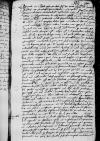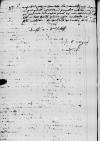Consilium magnifici domini Georg von Baysen (Jerzy Bażyński) (*1469 – †1546), 1503-1512 Chamberlain of Marienburg (Malbork); 1512-1546 Voivode of Marienburg (PSB 1, p. 377)⌊palatini paper damaged⌈[tini]tini paper damaged⌉ MarienburgensisGeorg von Baysen (Jerzy Bażyński) (*1469 – †1546), 1503-1512 Chamberlain of Marienburg (Malbork); 1512-1546 Voivode of Marienburg (PSB 1, p. 377)⌋ de contributo reservando usque ad proximum Provincial Diet of Royal Prussia ⌊conventumProvincial Diet of Royal Prussia ⌋ mihi non displiceret, si eius animi essemus omnes.[1] Verum, cum inter nos sint superinscribed⌈sintsint superinscribed⌉, qui potiores nostras sententias retractatas ms. retrectatas(!)
⌈retractatasretractatas ms. retrectatas(!)
⌉ velint et illis, quantum possunt, data opera reluctantur, ego id sequar, quod mandatum regium iubet. Video nos esse sub manu et sub ea ne hiscere quidem nobis licere, quod accidit, quia consilium nostrum divisum est. Aliis est res privata, aliis favor aulae, paucis res publica curae, ob quam solus ego male audio. Si nobis aetate gravis et prudens vir Georg von Baysen (Jerzy Bażyński) (*1469 – †1546), 1503-1512 Chamberlain of Marienburg (Malbork); 1512-1546 Voivode of Marienburg (PSB 1, p. 377)⌊dominus palatinusGeorg von Baysen (Jerzy Bażyński) (*1469 – †1546), 1503-1512 Chamberlain of Marienburg (Malbork); 1512-1546 Voivode of Marienburg (PSB 1, p. 377)⌋ decesserit, civitatibus, quae sua sunt, curantibus, parva mihi in reliquis spes est, et vereor, ne de privilegiis immunitatibusque nostris sit actum. Cumque iam nobis contra institutum nostrum ea vis adeo publice infertur, et ego iam non semel pro omnibus impegerim, ut written over et(?)⌈et(?) ut ut written over et(?)⌉ illam in me sustineam, longe viribus sum impar, qui sciam, quid possit et quid in fortioribus me effecerit, unde et mortis habuere causam.
Proinde omnem contributam pecuniam, cuius ne assem quidem sum visurus, cum primis Marienburg (Malbork), town and castle in northern Poland, Pomeranian Voivodeship, on the Nogat river, a branch of the Vistula at its delta, the capital of the Grand Masters of the Teutonic Order in Prussia (1309-1457), a voivodeship capital in Royal Prussia, which belonged to the Kingdom of Poland (1466-1772). Marienburg (taking turns with Graudenz (Grudziądz)) was the venue for the Provincial Diets of Royal Prussia, which were chaired by the bishop of Ermland (Warmia)⌊MarienburgumMarienburg (Malbork), town and castle in northern Poland, Pomeranian Voivodeship, on the Nogat river, a branch of the Vistula at its delta, the capital of the Grand Masters of the Teutonic Order in Prussia (1309-1457), a voivodeship capital in Royal Prussia, which belonged to the Kingdom of Poland (1466-1772). Marienburg (taking turns with Graudenz (Grudziądz)) was the venue for the Provincial Diets of Royal Prussia, which were chaired by the bishop of Ermland (Warmia)⌋ mittere constitui explicareque me ex hoc, quod igitur contra me natum est, odio, vel, ex eo si me expedire nequeo, curare illud non admodum atque perferre, ut pleraque alia, pectore infracto. Ab eo ne
cf. Vulg. Iac 5.17 Elias homo erat similis nobis passibilis ⌊Elias (Elijah), Hebrew prophet in the 9th century BC⌊HeliasElias (Elijah), Hebrew prophet in the 9th century BC⌋ quidem propheta fuit immunis etc.cf. Vulg. Iac 5.17 Elias homo erat similis nobis passibilis ⌋
Ceterum, quod Dominatio Vestra Reverendissima cum domino Georg von Baysen (Jerzy Bażyński) (*1469 – †1546), 1503-1512 Chamberlain of Marienburg (Malbork); 1512-1546 Voivode of Marienburg (PSB 1, p. 377)⌊palatino MarienburgensiGeorg von Baysen (Jerzy Bażyński) (*1469 – †1546), 1503-1512 Chamberlain of Marienburg (Malbork); 1512-1546 Voivode of Marienburg (PSB 1, p. 377)⌋ sortem meam doleant, gratiam habeo, non tamen puto necesse, quod quippiam ad illam aulam scribatur priusquam mihi ad cf. [Ioannes DANTISCUS] to [Sigismund I Jagiellon] Heilsberg (Lidzbark Warmiński), 1538-11-26, CIDTC IDL 2001;
[Ioannes DANTISCUS] to [Bona Sforza] Heilsberg (Lidzbark Warmiński), 1538-11-26, CIDTC IDL 2000⌊meascf. [Ioannes DANTISCUS] to [Sigismund I Jagiellon] Heilsberg (Lidzbark Warmiński), 1538-11-26, CIDTC IDL 2001;
[Ioannes DANTISCUS] to [Bona Sforza] Heilsberg (Lidzbark Warmiński), 1538-11-26, CIDTC IDL 2000⌋, quarum hic insunt exempla, responsum fuerit. Non abs re mihi videretur, quod copias cf. other letter [Council of Royal Prussia] Sigismund I Jagiellon Graudenz (Grudziądz) 1537-10-09, CIDTC IDT 666⌊litterarumcf. other letter [Council of Royal Prussia] Sigismund I Jagiellon Graudenz (Grudziądz) 1537-10-09, CIDTC IDT 666⌋ ad Sigismund I Jagiellon (Zygmunt I) (*1467 – †1548), King of Poland and Grand Duke of Lithuania (1506-1548); Duke of Głogów (Glogau) (1499-1506), Duke of Opava (1501-1506), Governor of Silesia (1504-1506); son of King Kazimierz IV Jagiellon and Elisabeth of Austria⌊maiestatem regiamSigismund I Jagiellon (Zygmunt I) (*1467 – †1548), King of Poland and Grand Duke of Lithuania (1506-1548); Duke of Głogów (Glogau) (1499-1506), Duke of Opava (1501-1506), Governor of Silesia (1504-1506); son of King Kazimierz IV Jagiellon and Elisabeth of Austria⌋ ex Provincial Diet of Royal Prussia ⌊conventu novissimo GraudentinoProvincial Diet of Royal Prussia ⌋ datarum, in quibus contributionis institutio habetur,[2] Dominatio Vestra Reverendissima transcribi curaret et Georg von Baysen (Jerzy Bażyński) (*1469 – †1546), 1503-1512 Chamberlain of Marienburg (Malbork); 1512-1546 Voivode of Marienburg (PSB 1, p. 377)
Johann von Lusian (Jan Luzjański) (*before 1470 – †1551), brother of Fabian von Lusian (Luzjański), Bishop of Ermland (Warmia); 1514-1551 Voivode of Kulm (Chełmno); 1520-1525 Burgrave of Rössel (Reszel) (PSB 18, p. 166-167)
Jerzy Konopacki Sr (Georg von Konopat) (*ca. 1480 – †1543), brother of Jan Konopacki, Bishop of Kulm (Chełmno); 1512-1516 Chamberlain of Pomerania; 1516-1518 Castellan of Gdańsk (Danzig); 1518-1543 Voivode of Pomerania (PSB 13, p. 547-548)⌊dominis palatinisGeorg von Baysen (Jerzy Bażyński) (*1469 – †1546), 1503-1512 Chamberlain of Marienburg (Malbork); 1512-1546 Voivode of Marienburg (PSB 1, p. 377)
Johann von Lusian (Jan Luzjański) (*before 1470 – †1551), brother of Fabian von Lusian (Luzjański), Bishop of Ermland (Warmia); 1514-1551 Voivode of Kulm (Chełmno); 1520-1525 Burgrave of Rössel (Reszel) (PSB 18, p. 166-167)
Jerzy Konopacki Sr (Georg von Konopat) (*ca. 1480 – †1543), brother of Jan Konopacki, Bishop of Kulm (Chełmno); 1512-1516 Chamberlain of Pomerania; 1516-1518 Castellan of Gdańsk (Danzig); 1518-1543 Voivode of Pomerania (PSB 13, p. 547-548)⌋, qui adscribed⌈quiqui adscribed⌉ illas secum ferre non solent, mitteret, quo, si qua defensio mihi foret necessaria, facilius conficeretur. Idipsum tamen prudentiae et benevolentiae in me Dominationis Vestrae Reverendissimae permitto.
Cum superioribus annis in sede essem Dominationis Vestrae Reverendissimae,[3] post conflagratum Kulm (Chełmno, Culma, Culmen), town in northern Poland, on the Vistula river, 40 km N of Thorn (Toruń)⌊oppidumKulm (Chełmno, Culma, Culmen), town in northern Poland, on the Vistula river, 40 km N of Thorn (Toruń)⌋ et ecclesiam,[4] quae ut restauraretur, pecunia ex sacerdotum fraternitate communi consensu insumpta est. Quam, ut edoctus sum, Kazanice parish priest ⌊CasnicensisKazanice parish priest ⌋ et parish priest of Löbau ⌊Lubaviensisparish priest of Löbau ⌋ parrochi ab ecclesiae provisoribus repetere nituntur, quod cum iniquum sit, avarulum illum suum, qui forsan cum pecuniis velit negotiari, comprimat,
cf. Pl. Am. 885 ea quae sunt facta infecta ut reddat clamitat ⌊ne, quae pie facta sunt, per impios reddantur  BCz, 245, p. 110 infectacf. Pl. Am. 885 ea quae sunt facta infecta ut reddat clamitat ⌋. Quae in societate illa sacerdotum erant deposita, in pios quidem usus et non privatos cedebant. Nisi fuisset ea pecunia et nescio quid ex me adminiculi, adhuc omnia in loco ecclesiae plena essent ruderibus.
BCz, 245, p. 110 infectacf. Pl. Am. 885 ea quae sunt facta infecta ut reddat clamitat ⌋. Quae in societate illa sacerdotum erant deposita, in pios quidem usus et non privatos cedebant. Nisi fuisset ea pecunia et nescio quid ex me adminiculi, adhuc omnia in loco ecclesiae plena essent ruderibus.
Dominatio Vestra Reverendissima feliciter valeat.
 BCz, 245, p. 110 infectacf. Pl. Am. 885 ea quae sunt facta infecta ut reddat clamitat ⌋. Quae in societate illa sacerdotum erant deposita, in pios quidem usus et non privatos cedebant. Nisi fuisset ea pecunia et nescio quid ex me adminiculi, adhuc omnia in loco ecclesiae plena essent ruderibus.
BCz, 245, p. 110 infectacf. Pl. Am. 885 ea quae sunt facta infecta ut reddat clamitat ⌋. Quae in societate illa sacerdotum erant deposita, in pios quidem usus et non privatos cedebant. Nisi fuisset ea pecunia et nescio quid ex me adminiculi, adhuc omnia in loco ecclesiae plena essent ruderibus.


